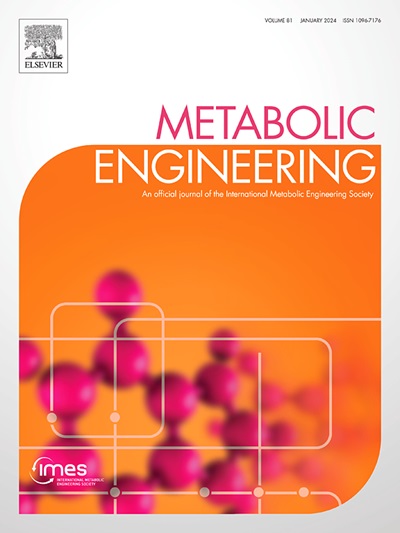Carbon-conserving bioproduction of malate in an E. coli-based cell-free system
IF 6.8
1区 生物学
Q1 BIOTECHNOLOGY & APPLIED MICROBIOLOGY
引用次数: 0
Abstract
Formate, a biologically accessible form of CO2, has attracted interest as a renewable feedstock for bioproduction. However, approaches are needed to investigate efficient routes for biological formate assimilation due to its toxicity and limited utilization by microorganisms. Cell-free systems hold promise due to their potential for efficient use of carbon and energy sources and compatibility with diverse feedstocks. However, bioproduction using purified cell-free systems is limited by costly enzyme purification, whereas lysate-based systems must overcome loss of flux to background reactions in the cell extract. Here, we engineer an E. coli-based system for an eight-enzyme pathway from DNA and incorporate strategies to regenerate cofactors and minimize loss of flux through background reactions. We produce the industrial di-acid malate from glycine, bicarbonate, and formate by engineering the carbon-conserving reductive TCA and formate assimilation pathways. We show that in situ regeneration of NADH drives metabolic flux towards malate, improving titer by 15-fold. Background reactions can also be reduced 6-fold by diluting the lysate following expression and introducing chemical inhibitors of competing reactions. Together, these results establish a carbon-conserving, lysate-based cell-free platform for malate production, producing 64 μM malate after 8 h. This system conserves 43 % of carbon otherwise lost as CO2 through the TCA cycle and incorporates 0.13 mol CO2 equivalents/mol glycine fed. Finally, techno-economic analysis of cell-free malate production from formate revealed that the high cost of lysate is a key challenge to the economic feasibility of the process, even assuming efficient cofactor recycling. This work demonstrates the capabilities of cell-free expression systems for both the prototyping of carbon-conserving pathways and the sustainable bioproduction of platform chemicals.

以大肠杆菌为基础的无细胞系统中苹果酸盐的碳保存生物生产
甲酸盐是一种生物可获得的二氧化碳形式,作为生物生产的可再生原料引起了人们的兴趣。然而,由于甲酸酯的毒性和微生物利用有限,需要研究有效的生物同化途径。无细胞系统由于其有效利用碳和能源的潜力以及与各种原料的兼容性而具有前景。然而,使用纯化的无细胞系统的生物生产受到昂贵的酶纯化的限制,而基于裂解物的系统必须克服细胞提取物中背景反应的通量损失。在这里,我们设计了一个基于大肠杆菌的系统,用于DNA的八酶途径,并结合了再生辅助因子和通过背景反应最小化通量损失的策略。我们通过设计碳保护还原性TCA和甲酸同化途径,从甘氨酸、碳酸氢盐和甲酸酯中生产工业用苹果酸二酸酯。我们发现NADH的原位再生驱动了苹果酸盐的代谢通量,将滴度提高了15倍。通过在表达后稀释裂解物并引入竞争反应的化学抑制剂,背景反应也可以减少6倍。综上所述,这些结果建立了一个碳节约、基于裂解液的无细胞苹果酸生产平台,在8小时后生产64 μM苹果酸。该系统通过TCA循环节省了43%的碳,其他碳作为二氧化碳损失,并且每mol甘氨酸添加0.13 mol CO2当量。最后,对甲酸生产无细胞苹果酸的技术经济分析表明,裂解液的高成本是该工艺经济可行性的关键挑战。即使假设有效的辅因子回收。这项工作证明了无细胞表达系统在碳保存途径的原型设计和平台化学品的可持续生物生产方面的能力。
本文章由计算机程序翻译,如有差异,请以英文原文为准。
求助全文
约1分钟内获得全文
求助全文
来源期刊

Metabolic engineering
工程技术-生物工程与应用微生物
CiteScore
15.60
自引率
6.00%
发文量
140
审稿时长
44 days
期刊介绍:
Metabolic Engineering (MBE) is a journal that focuses on publishing original research papers on the directed modulation of metabolic pathways for metabolite overproduction or the enhancement of cellular properties. It welcomes papers that describe the engineering of native pathways and the synthesis of heterologous pathways to convert microorganisms into microbial cell factories. The journal covers experimental, computational, and modeling approaches for understanding metabolic pathways and manipulating them through genetic, media, or environmental means. Effective exploration of metabolic pathways necessitates the use of molecular biology and biochemistry methods, as well as engineering techniques for modeling and data analysis. MBE serves as a platform for interdisciplinary research in fields such as biochemistry, molecular biology, applied microbiology, cellular physiology, cellular nutrition in health and disease, and biochemical engineering. The journal publishes various types of papers, including original research papers and review papers. It is indexed and abstracted in databases such as Scopus, Embase, EMBiology, Current Contents - Life Sciences and Clinical Medicine, Science Citation Index, PubMed/Medline, CAS and Biotechnology Citation Index.
 求助内容:
求助内容: 应助结果提醒方式:
应助结果提醒方式:


